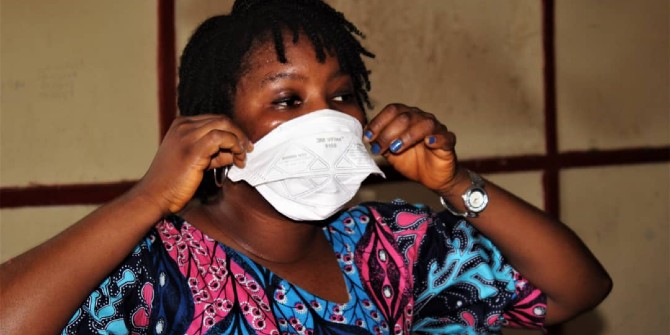Supporting emerging economies at the time of COVID-19 will be the next global challenge and that is where multilateral and bilateral policy coordination is going to focus, with international and regional Finance Institutions being called “to assert the full weight of their resources”. One should hope that that the pandemic will move international cooperation not only in the direction of helping recirculate the capital that is leaving the emerging economies back to them but it will create long-lasting ways to address inequalities and strengthen global governance, write Amit Kara, Corrado Macchiarelli (NIESR) and Renato Giacon (EBRD).
The policy response to the COVID-19 pandemic in the advanced world has been swift and synchronous but largely uncoordinated. Collectively the measures taken are expected to deliver positive spillovers by saving lives everywhere and supporting economic activity but, going forward, given the scale of the shock and the risk of long-term scarring, there is a compelling case for international policy coordination to restore both public health and the health of the global economy.
Fiscal policy has played a dominant role in many developed economies, such as Australia, France, Germany, Italy, Japan, Spain, the UK, and the US. That fiscal support will cushion the impact of the pandemic in each of these countries and the collective action will serve to amplify the benefits. The US Federal Reserve and the Bank of Canada have had the space to lower the main overnight policy rate by 150 basis points but, in general, central banks have had to rely more on asset purchases and term funding schemes because their policy rates were already close to the lower bound. These interventions have helped to restore confidence in domestic and international financial markets and the real economy rather than raise aggregate demand per se. One notable exception to the uncoordinated action is the provision of US dollars to a group of central banks through swap lines with the Federal Reserve.
Sovereign debt levels are projected to rise across the world as a result of this pandemic. There is a wide spectrum of indebtedness among advanced economies, with economies such as Australia and Germany, that started with low levels of debt, likely to face little difficulty with debt servicing. At the other end of the spectrum is Italy, which entered the pandemic with a government debt-to-GDP ratio in excess of 130 per cent and low potential economic growth. A low inflation environment will allow for now central banks to intervene in countries like Italy, which can then live with high levels of debt in much the same way Japan has for the past two decades. The monetary stimulus announced by the European Central Bank in March (€750 billion asset purchase programme of private and public sector securities through the Pandemic Emergency Purchase Programme (PEPP)), is an example of indirect central bank support in a low inflation environment and one that will help the sovereign bond risk of highly indebted countries to remain at manageable levels.
Once the dust settles, questions about the optimal debt level and fiscal consolidation are bound to emerge for these and other countries such as the UK and France. Low and well-anchored inflation expectations – whether at the current target or slightly higher levels – will help these countries maintain high debt levels for a prolonged period of time. There is a need for academics and central bankers to revisit the appropriateness of the current inflation target in light of the zero bound and generally higher levels of indebtedness.

The fiscal and monetary response of emerging economies has been muted in comparison and that largely reflects an inability rather than an unwillingness to respond. Some economies have limited fiscal and monetary policy space as might be captured by the positive correlation between fiscal deficits and borrowing costs. These constraints have been magnified by the ‘sudden-stop’ in capital flows. There has been a record outflow of portfolio money from emerging economies according to data from the Institute of International Finance (IIF) and this has led to currency depreciation and raised the prospect of higher inflation. Some of these countries depend on foreign income from a combination of commodity exports, tourism, and remittances, all of which are expected to weaken. Central banks in India, Colombia, Brazil, Peru, the Philippines, and South Africa have all begun to (or acquired the legal right to) buy government and private sector bonds on secondary markets, thus moving in the same direction of advanced economies since the 2008 Global Financial Crisis. However, the likelihood of inflation expectations getting unhinged is higher in those countries, given that inflation targets are only a recent introduction.
A combination of devaluation and austerity is no longer a recipe for sustainable long-term growth in emerging markets especially against a backdrop of collapsing revenues and external financing constraints. There are compelling reasons for the international community to coordinate a clear agenda that addresses not only the need to stem the spread of the virus and maximise the benefits of the various relief packages forthwith but also that can tackle longer-term issues, such as restoring confidence in emerging markets and protect global supply chains. Policies also need to be developed to ensure that the longer-term scarring effects of this crisis are minimised.
International institutions, such as the IMF, are responding to financing requests from more than 100 countries through its Rapid Financing Instrument and Rapid Credit Facility. The international community could, with the help of the IMF and World Bank, consider debt write-offs for the most indebted economies, especially in Sub-Saharan Africa.
International and regional development finance institutions such as the IFC and the EBRD would complement this effort by immediately supporting specific target groups – e.g. SMEs, critical industrial clients, as well as public sector utilities, municipal operators and key infrastructure providers – via restructuring and refinancing packages, emergency liquidity and working capital, trade finance facilities, local currency financing, while also setting up pipelines of post-crisis investment plans to help restore confidence. A good example is the recently approved 4 billion EUR financing made available from EBRD – which was the first DFI to pledge in March 2020 a Resilience Framework as part of an ad-hoc Coronavirus Solidarity Package.
Similar – but much larger in size – efforts are underway for struggling developed economies such as, for instance, the €540 billion support package announced by the European Council via the European Stability Mechanism (ESM), the European Investment Bank (EIB) and the European Commission SURE Programme. These latter funds are specifically earmarked for companies and workers.
To conclude, the COVID-19 pandemic has brought into sharp focus the policy space that is available to countries. More advanced countries have been able to deploy a wide array of tools to protect the health of their citizens and provide support to households and businesses. Emerging economies have faced the double whammy of the pandemic and a heavily constrained set of policy options which have been squeezed even further by the fallout of the large outflow of portfolio money. The response to this has to be coordinated and should in the first instance protect lives and restore confidence in these markets.
After the emergency will be over, however, global leaders will have the responsibility to safeguard the existing web of relations that has brought economies together post-Bretton Woods and built prosperity. Keeping international trade open is now crucial for the maximisation of resources for a rapid recovery globally. (Clearly, national channels will retain their pivotal role in facilitating collaboration in the field of the economy, finance, health, and the environment, leveraging on national, regional, city-level, and sector-specific knowledge.) Even more importantly, countries will need to resist the impulse of stopping trade concerning healthcare and the exchange of scientific information. Past the recovery, however, longer-term cooperation through multilateralism will be key in ensuring the built of future resilience and debt sustainability, especially for emerging markets.
This post represents the views of the authors and not those of the COVID-19 blog or LSE or EBRD. Image by – Flickr: Curitiba Centro: CC BY 2.0






1 Comments